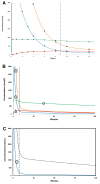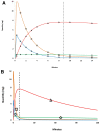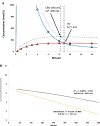Four-Compartment Diffusion Model of Cortisol Disposition: Comparison With 3 Alternative Models in Current Clinical Use
- PMID: 36628386
- PMCID: PMC9815201
- DOI: 10.1210/jendso/bvac173
Four-Compartment Diffusion Model of Cortisol Disposition: Comparison With 3 Alternative Models in Current Clinical Use
Abstract
Context: Estimated rates of cortisol elimination and appearance vary according to the model used to obtain them. Generalizability of current models of cortisol disposition in healthy humans is limited.
Objective: Development and validation of a realistic, mechanistic model of cortisol disposition that accounts for the major factors influencing plasma cortisol concentrations in vivo (Model 4), and comparison to previously described models of cortisol disposition in current clinical use (Models 1-3).
Methods: The 4 models were independently applied to cortisol concentration data obtained for the hydrocortisone bolus experiment (20 mg) in 2 clinical groups: healthy volunteers (HVs, n = 6) and corticosteroid binding globulin (CBG)-deficient (n = 2). Model 4 used Fick's first law of diffusion to model free cortisol flux between vascular and extravascular compartments. Pharmacokinetic parameter solutions for Models 1-4 were optimized by numerical methods, and model-specific parameter solutions were compared by repeated measures analysis of variance. Models and respective parameter solutions were compared by mathematical and simulation analyses, and an assessment tool was used to compare performance characteristics of the four models evaluated herein.
Results: Cortisol half-lives differed significantly between models (all P < .001) with significant model-group interaction (P = .02). In comparative analysis, Model 4 solutions yielded significantly reduced free cortisol half-life, improved fit to experimental data (both P < .01), and superior model performance.
Conclusion: The proposed 4-compartment diffusion model (Model 4) is consistent with relevant experimental observations and met the greatest number of empiric validation criteria. Cortisol half-life solutions obtained using Model 4 were generalizable between HV and CBG-deficient groups and bolus and continuous modes of hydrocortisone infusion.
Keywords: albumin; compartmental modeling; computer-assisted; corticosteroid binding globulin (CBG); cortisol; hydrocortisone; metabolic clearance rate; numerical analysis; septic shock.
Published by Oxford University Press on behalf of the Endocrine Society 2022.
Figures




References
-
- Keenan DM, Roelfsema F, Veldhuis JD. Endogenous ACTH concentration-dependent drive of pulsatile cortisol secretion in the human. Am J Physiol Endocrinol Metab. 2004;287(4):E652–E661. - PubMed
-
- Mendel CM. The free hormone hypothesis: a physiologically based mathematical model. Endocr Rev. 1989;10(3):232–274. - PubMed
-
- Burt MG, Mangelsdorf BL, Rogers A, et al. . Free and total plasma cortisol measured by immunoassay and mass spectrometry following ACTH(1)(-)(2)(4) stimulation in the assessment of pituitary patients. J Clin Endocrinol Metab. 2013;98(5):1883–1890. - PubMed
LinkOut - more resources
Full Text Sources
Research Materials
Miscellaneous
